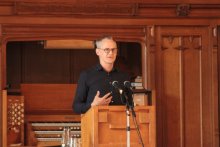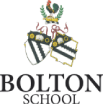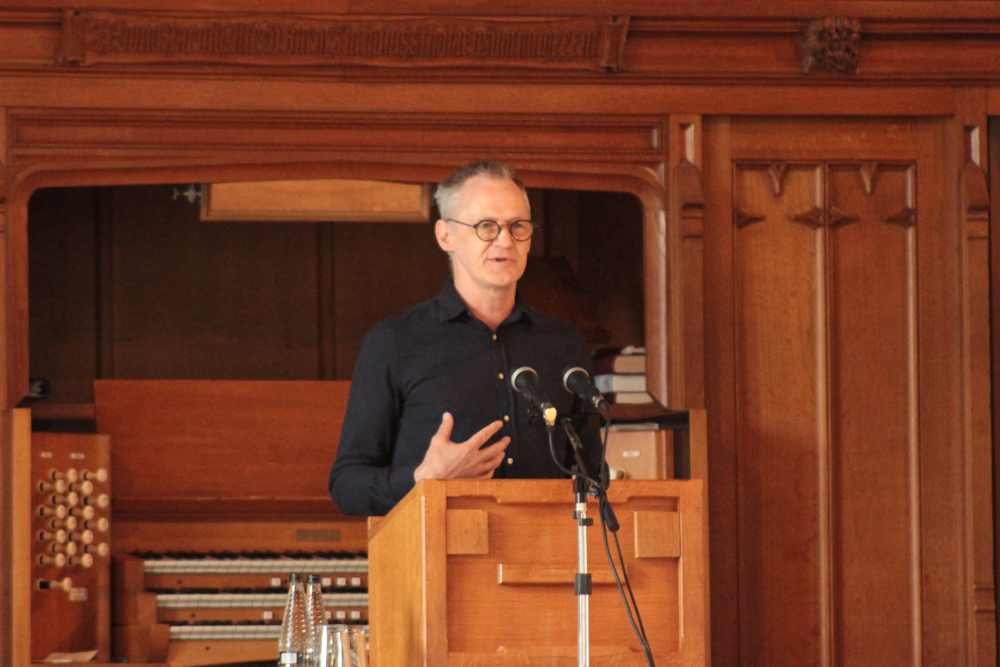
Bolton School Old Boy Rob Dobson returned to deliver the first ever Hulton Lecture. This new Primary Division lecture series is aimed at pupils in Year 6 and their families, and will complement the Boys’ Division Tillotson Lecture and Girls’ Division Platt Fisher Lecture.
Mrs Sue Faulkner, the Head of Primary Division, welcomed the audience to the Girls’ Division Great Hall before handing over to Junior Boys’ representative Jayden Shah (Year 6), who introduced Rob and welcomed him to the stage.
Rob’s talk focused on engineers and how they solve the world’s problems. In his opening, he told the audience of young people that he hoped to cast a little light on what engineers do. He began by talking through some of the challenges that the planet faces, from climate change and plastic pollution to the increasing need for energy and food production and how to achieve these efficiently while causing less damage to the environment. Rob then described the characteristics of the people who will tackle these problems.
He briefly touched on the UK’s wonderful history around engineering, featuring steam engines, ships, bridges and industrial machines. However, while the stereotype of dirty overalls and engines may be where the term ‘engineer’ originated, it is now so much more. Today’s engineers turn science and maths into things that can be used to make the world a better place.
Rob next took the audience on a whistle-stop tour of just some of the everyday things that owe their existence to engineers. Buses, trains and cars are designed by automotive engineers; roads and buildings by civil engineers; and games and apps by software engineers. Robotics engineers automate factories and tackle dangerous jobs, while materials engineers make high-tech clothing and insulation.
Turning to the question of how engineers work, Rob spoke about the importance of using computers to ‘model the world’. He explained that simulations can predict what will happen in the real-world, and by using these to safely test out ideas, engineers can solve problems that impact the world and make everyone’s lives easier, safer and more comfortable.
Moving on to talk a little about himself and how he became an engineer, Rob started by saying, ‘As you can probably tell, I love computers!’ His interest began in the Junior Boys’ School when he built a cardboard robot with boys who are still his friends today. He went on to build his first computer in 1977, while still a Bolton School pupil, using an old calculator case: it had 256 bytes of memory, 256 bytes of RAM, no graphics or screen, and the ability to save programs on cassette tape. The pictures he showed were very different to the computers of today, and smartphones have a million times more memory! However, it was only when he was in his final year at school that he realised that a lot of what he enjoyed doing, problem-solving and making electronic and mechanical items, was embodied in a set of job that people did, and those people are engineers.
Circling back, Rob briefly talked through the history of computers and the engineers behind the advances. He talked about Charles Babbage’s sophisticated mechanical computer, Konrad Zuse in Germany who achieved a rate of one calculation per second for the first time in the 1930s, and Tommy Flowers and Alan Turing who developed early electronic computers. In 1948, the first stored program computer was built based on the ideas of Turing and Von Neumann: the Manchester Baby! Further developments saw large-scale ‘Ferranti Mini-computers’ made in Manchester in the 1960s.
Moving into the 1970s, Rob brought the story back to Bolton School with the School’s first computers. The Boys’ Division got two TRS80 computers around 1978, but the Girls’ Division got the better RML 380Z around the same time. He remembered that the only time he spent in the Girls’ Division was to use those computers!
Earlier in the talk, Rob set the audience a challenge: how fast could they compute 21.98 ÷ 7? He was very impressed by how instantly some of the children’s hands shot into the air! He said that anything under 30 seconds was pretty good, and compared this rate to some historical computers. Babbage’s 1820s model could do less than one calculation per second as it was hand-cranked; his 1977 computer could achieve maybe 20,000 per second; and modern computers can manage 125 quadrillion!
Rob explained that engineers are in a great position to start tech companies and spoke briefly about some of the engineers he has helped with their startups: Sandy and blue educational robot Marty; Alison and the G-Hold, which helps people to comfortably hold tablets; and Ravi and Deborah’s Wootzano, a robot that can test fruit for ripeness and safely pack it. He also briefly touched on the fact that engineers have a problem-solving skill-set that makes them good at running companies, as attested by the statistic that over 30% of CEOs in the biggest companies in the world are engineers. For the parents, Rob also noted that 18% of the working population in the UK work in engineering and these jobs are among the highest paid in the UK! He used his daughter Grace as a case study to exemplify this.
After a little light humour – how many engineers does it take to change a light bulb? Zero, because engineers have developed LED light bulbs that last so long you never need to change them! – Rob returned to his original premise. The world has a lot of challenges to face, and engineers need to be creative to find solutions to problems such as: transportation that doesn’t pollute, food production with lower environmental impact, faster internet connections for everyone, health solutions for the world’s population, robots to automate dangerous and slow tasks, energy availability everywhere at low cost, and many more.
However, engineers use their imagination to come up with new ideas and designs that no one has thought of before. They work with cutting-edge technology and materials to make impossible things into reality. He said that engineers need a curious mind, an interest in solving problems and a desire to keep learning.
Finally, he encouraged the young people in the audience to become and engineer and help to fix the broken bits of the world.
Following a brief but lively question and answer session, Junior Girls’ representative Shalom Chigara (Year 6) thanked Rob for his fascinating talk and for inspiring this next generation of Bolton School pupils to find ways to solve the world’s problems.
Keynote speaker Rob Dobson attended the Junior Boys’ School (Park Road) from 1972 to 1975 and left the Boys’ Division in 1982. He gained a first-class degree in Electronic Engineering from the University of Southampton and went on to found Actix, a tech business focused on algorithmic optimisation for mobile phone networks, growing the business to over 200 people with offices in eight locations around the world. Rob, who was the Boys’ Division Prizegiving Speaker in June 2017, is now one of the most active independent angel investors in Scotland and is passionate about empowering young people to start their own businesses.
The Hulton Lecture is named in recognition of the Hulton Charity Trust, whose links with education in Bolton can be traced back to the 17th Century. The trust was inspired by Nathaniel Hulton's desire to promote religion, learning and charity and whilst the school no longer holds the religious affiliations of the past, learning and charity remain at the heart of all that we do at Bolton School. The original Beech House was the home of one of the Hulton Trustees, Ralph Haslam, and later purchased by the School to be used first as the home of the Boys' Junior School and then later as the Infant School. There were Hulton Scholarships to University in Boys' Division and a Hulton Lecture in Girls' Division for many years. This link with Girls' Division is also rooted in the fact the Hulton Trust was involved in the construction of the original Bank Street Chapel, in 1696, and it was members of that congregation who inspired the creation of the original Bolton High School for Girls. As we embark on the new tradition of the Primary Division lecture programme, it is therefore fitting that we look into our past, and honour the long-standing connection between Bolton School and the Hulton Charity Trust.
A gallery of photos from Rob's visit is below:










.jpg&command_2=resize&height_2=85)
.jpg&command_2=resize&height_2=85)












